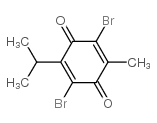2,5-Dibromo-3-isopropyl-6-methylbenzoquinone

2,5-Dibromo-3-isopropyl-6-methylbenzoquinone structure
|
Common Name | 2,5-Dibromo-3-isopropyl-6-methylbenzoquinone | ||
|---|---|---|---|---|
| CAS Number | 29096-93-3 | Molecular Weight | 321.99300 | |
| Density | 1.8g/cm3 | Boiling Point | 318ºC at 760mmHg | |
| Molecular Formula | C10H10Br2O2 | Melting Point | 70-72ºC(lit.) | |
| MSDS | Chinese USA | Flash Point | 87.7ºC | |
| Symbol |

GHS07 |
Signal Word | Warning | |
|
NMR reveals double occupancy of quinone-type ligands in the catalytic quinone binding site of the Na+-translocating NADH:Quinone oxidoreductase from Vibrio cholerae.
J. Biol. Chem. 288(42) , 30597-606, (2013) The sodium ion-translocating NADH:quinone oxidoreductase (Na(+)-NQR) from the pathogen Vibrio cholerae exploits the free energy liberated during oxidation of NADH with ubiquinone to pump sodium ions across the cytoplasmic membrane. The Na(+)-NQR consists of f... |
|
|
Net light-induced oxygen evolution in photosystem I deletion mutants of the cyanobacterium Synechocystis sp. PCC 6803.
Biochim. Biophys. Acta 1817(5) , 792-801, (2012) Oxygenic photosynthesis in cyanobacteria, algae, and plants requires photosystem II (PSII) to extract electrons from H(2)O and depends on photosystem I (PSI) to reduce NADP(+). Here we demonstrate that mixotrophically-grown mutants of the cyanobacterium Synec... |
|
|
Interaction of exogenous quinones with membranes of higher plant chloroplasts: modulation of quinone capacities as photochemical and non-photochemical quenchers of energy in Photosystem II during light-dark transitions.
Biochim. Biophys. Acta 1604(2) , 115-23, (2003) Light modulation of the ability of three artificial quinones, 2,5-dibromo-3-methyl-6-isopropyl-p-benzoquinone (DBMIB), 2,6-dichloro-p-benzoquinone (DCBQ), and tetramethyl-p-benzoquinone (duroquinone), to quench chlorophyll (Chl) fluorescence photochemically o... |
|
|
A chloroplast retrograde signal regulates nuclear alternative splicing.
Science 344(6182) , 427-30, (2014) Light is a source of energy and also a regulator of plant physiological adaptations. We show here that light/dark conditions affect alternative splicing of a subset of Arabidopsis genes preferentially encoding proteins involved in RNA processing. The effect r... |
|
|
Kinetic analyses of the OJIP chlorophyll fluorescence rise in thylakoid membranes.
Photosynth. Res. 84(1-3) , 107-12, (2005) N,N,N',N'-tetramethyl-p-phenylenediamine (TMPD) was previously used to study the kinetics of the OJIP chlorophyll fluorescence rise. The present study is an attempt to elucidate the origin of TMPD-induced delay and quenching of the I-P step of fluorescence ri... |
|
|
Moderate heat stress induces state transitions in Arabidopsis thaliana.
Biochim. Biophys. Acta 1807(9) , 1177-84, (2011) The effect of temperature on the photosynthetic machinery is crucial for the fundamental understanding of plant physiology and the bioengineering of heat-tolerant varieties. In our study, Arabidopsis thaliana was exposed to mild (40°C), short-term heat stress... |
|
|
Temperature-induced greening of Chlorella vulgaris. The role of the cellular energy balance and zeaxanthin-dependent nonphotochemical quenching.
Planta 217(4) , 616-27, (2003) When cells of the green alga Chlorella vulgaris Beij. are transferred from growth at 5 degrees C and an irradiance of 150 micromol photons m(-2) s(-1) to 27 degrees C and the same irradiance, they undergo what is normally considered a high-light to low-light ... |
|
|
Quinone sensing by the circadian input kinase of the cyanobacterial circadian clock.
Proc. Natl. Acad. Sci. U. S. A. 103(46) , 17468-73, (2006) Circadian rhythms are endogenous cellular programs that time metabolic and behavioral events to occur at optimal times in the daily cycle. Light and dark cycles synchronize the endogenous clock with the external environment through a process called entrainmen... |
|
|
Transcriptional regulation of the bidirectional hydrogenase in the cyanobacterium Synechocystis 6803.
J. Biotechnol. 142(1) , 31-7, (2009) To identify optimal conditions for renewable hydrogen production from sunlight and water we have studied transcriptional changes of the hoxEFUYH genes encoding the bidirectional hydrogenase in the cyanobacterium Synechocystis PCC 6803. Transcript abundance de... |
|
|
Comparison of carotenoid content, gene expression and enzyme levels in tomato (Lycopersicon esculentum) leaves.
Z. Naturforsch., C, J. Biosci. 58(5-6) , 371-80, (2003) Physiological conditions which lead to changes in total carotenoid content in tomato plantlets were identified. Carotenoid levels were found to increase after the onset of a dark period during a normal 24 h cycle. This rapid initial increase is followed by a ... |